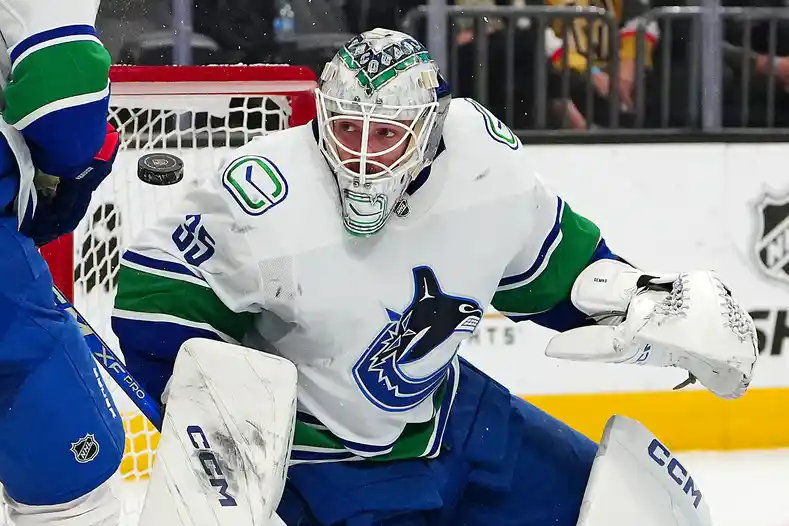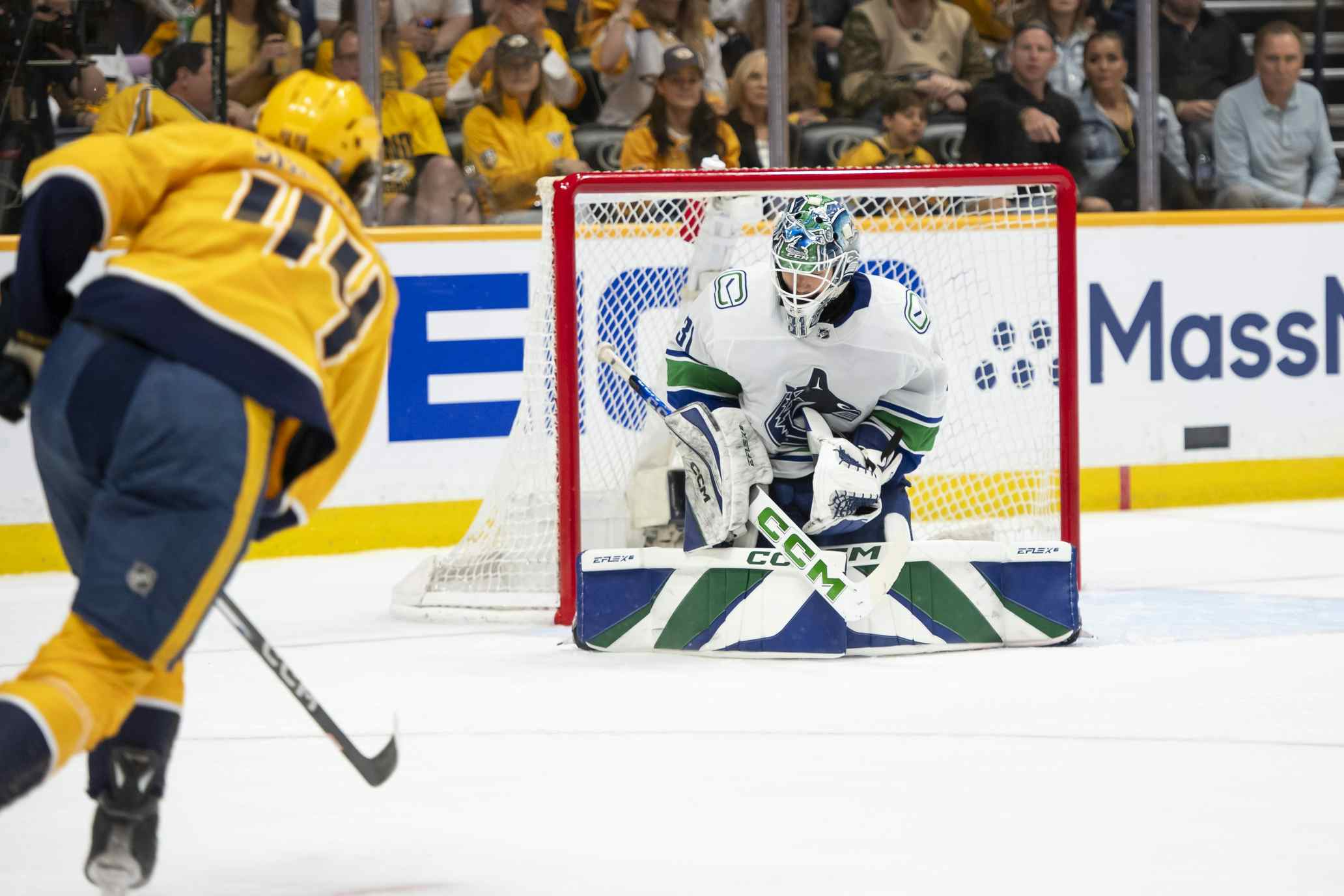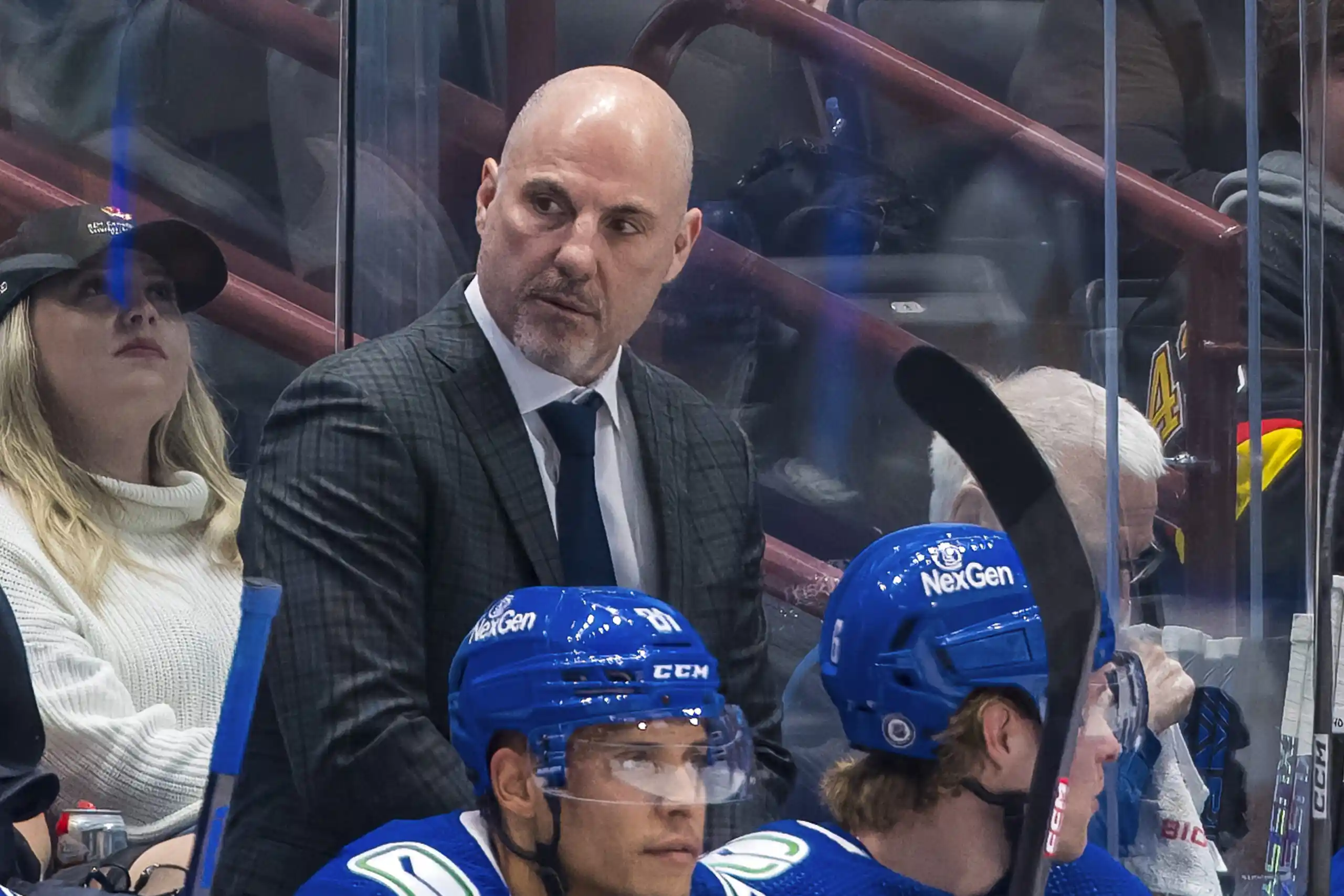Benning’s Year 1 Report Card – Part 3 – 2014 Draft Revisited
By money puck
8 years ago
Photo Credit: Bill Streicher / USA TODAY Sports
In the first two parts of this series, I reviewed the trades and free agent signings made by Jim Benning in his first year running the Canucks front office. I first wrote about the 2014 draft last summer, but let’s see how views have changed now that the prospects have another year of development under their belts.
Click past the jump for the third of a three part series grading Jim Benning’s first season as Vancouver’s general manager.
| Overall | Player | Grade |
|---|---|---|
| 6 | Jake Virtanen | 6.50 |
| 24 | Jared McCann | 8.50 |
| 36 | Thatcher Demko | 8.00 |
| 66 | Nikita Tryamkin | 6.00 |
| 126 | Gustav Forsling | 8.50 |
| 156 | Kyle Pettit | 4.00 |
| 186 | Mackenze Stewart | 4.00 |
#6 OVERALL – JAKE VIRTANEN – Grade 6.5
My first contribution to this blog was made almost a year ago in a piece where Rhys discussed both Virtanen and Nikolaj Ehlers. The gist of the argument is that Virtanen is a very good player, but not the best player available at #6 overall. In my deep dive on the draft later that summer, I broke down why I thought William Nylander was also a superior option to Virtanen at #6 overall If the Canucks were picking 10th overall, it’s fair to say that most of us would be happy with the prospect of taking Virtanen. I think there’s a high degree of likelihood that he’ll turn into an NHLer, and its a good sign that he’s been trusted to play 10 playoff games for Utica at 18 years old, even if his production was limited to a single assist.
The point of this article isn’t “is Jake Virtanen good?”, its “how did Benning perform at the 2014 draft?”, and to assess that you really need to look at the performance of those who Benning passed on, and in order to do that I need to kick the dead horse one more time.
We’ve recently rolled out a two prospect evaluation tools, PCS% and PCS p/GM. A summary can be found here, but in general we look at the closest comparables to a player in terms of age, league, scoring, and height, and calculate what percentage of those peers became NHLers (PCS%), and what the NHL points-per-game rate was for those who played in the NHL (PCS p/GM).
Here is PCS% for the 17 and 18 year-old seasons for Virtanen, Ehlers, and Nylander:

*note: For Virtanen and Ehlers the all CHL leagues included in Sample. For Nylander, SHL used for his 17 year-old season and AHL used for his 18 year-old season. Nylander’s compared to players one year old in AHL as there were no players who had scored at a comparable rate in that league to Nylander at his 18 years of age.
As we can see, the peers for Ehlers and Nylander went on to successful NHL careers at a much higher rate than Virtanen. Virtanen was coming off an injury last summer, which hampered his development this season, so in my view his chances of making it are far closer to the 29% we saw last year than the 11% we see this year, but we can see that again, Nylander and Ehlers were clearly superior options, then and now in terms of likelihood of making the NHL.
While PCS is instructive in assessing what the likelihood is that a player will make the NHL, PCS p/GM can provide insight in terms of what type of player they’ll be when they get there. Here is the PCS p/GM for Ehlers, Nylander, and Virtanen:

The PCS p/GM in the 0.6 range indicates that a peers of Ehlers and Nylander averaged the equivalent of 50 points a year (over an 82 game season) over the course of their careers, which is roughly 1st line scoring potential. Virtanen’s peers averaged in the 40 point a year range.
While I do like a lot about Virtanen, and think he’s got a pretty good shot at eventually contributing at the NHL level, when you’re making a top 10 pick you really have to take the best player available. They didn’t do that. In fact they passed on two players who were obviously superior then, and continue to be obviously superior today.
#24 OVERALL – JARED MCCANN – 8.5

As much as I dislike the Virtanen selection at 6, I love the McCann selection at 24. After an exceptional 16 year-old season, McCann’s draft stock slid as the Greyhounds had him focus on being the team’s shut down center, much to the benefit of the Canucks. It very much looks like McCann could be the teams future 2nd or 3rd line center, which is a win at 26th overall.
#36 OVERALL – THATCHER DEMKO – 8.0
Demko led the NCAA this season in terms of save percentage for players under 20, with a sv% of .925, This marked a slight improvement from his sv% of .919 last year, which was top for U19 goalies. He was extremely impressive at the World Juniors where he posted a .934 sv% for team USA. Demko is a few years away from being a NHL contributor, but he’s an excellent goaltending prospect. This is looking like a very good selection for the Canucks at 36th overall.
#66 OVERALL – NIKITA TRYAMKIN – 6.0
Last summer when I reviewed the Tryamkin pick I concluded that it was a worthwhile gamble picking a big, late blooming defensemen, who had showed enough improvement to warrant a spot in the top 4 on Russia’s World Junior team. Unfortunately, it looks like Tryamkin took a step backwards, seeing his ice time reduced from 16:30 per game in 2013/14 to 14:15 this year, and less than 10 minutes a game in the playoffs. Avtomobilist was a middle of the pack team this year in the KHL, so the lack of progression we’ve seen from Tryamkin is concerning.
#126 OVERALL – GUSTAV FORSLING – 8.5
Good things happen when you draft skill. Last year, Forsling was in the top 5 in scoring amongst U18 defensement in SuperElit, Sweden’s junior program. Forsling had a stellar World Junior tournament, with 3 goals and 8 points in 7 games, which Benning was able to monetize in a trade for Adam Clendening which I lauded earlier in this series. Excellent draft selection.
#156 OVERALL – KYLE PETTIT – 4.0

Pettit has roughly a 1 in 20 shot of being a 4th line player. As I detailed earlier, there were a number of high potential picks available at the end of the draft, including Vlad Tkackev, Sebastian Aho, and Joe Hicketts. The Pettit pick was simply not a good use of assets.
#186 OVERALL – MACKENZE STEWART – 4.0

Repeat everything I just said about Pettit and apply to a defenseman. There is literally no point in drafting players like Pettit or Stewart because at best they’ll develop into replacement level players you can sign each summer for the league minimum.
CONCLUSION – Overall Grade 6.5
With their first round picks, the Canucks look like they got two future NHLers in Virtanen and McCann, and in Demko they selected the best available goaltender in the draft. In Forsling, they were able to convert a 5th round selection into an NHL ready defensemen, so in all there are a fair amount of positives in what the Canucks accomplished last draft.
However, they passed on two players, Nylander and Ehlers, with much higher offensive ceilings than Virtanen, and very probably wasted their last two picks on over-sized, and under-skilled non-prospects. While I do think the Canucks drafted NHLers in the 2014 draft, I fear it will be remember more for opportunities squandered, than as a crowning achievement for the Benning administration. I sincerely hope I’m wrong.
Others In This Series
Recent articles from money puck





